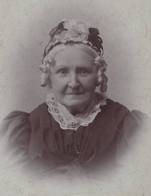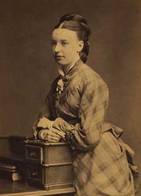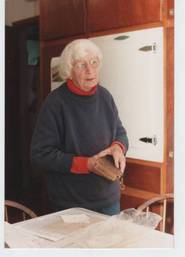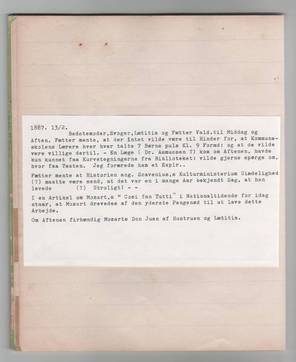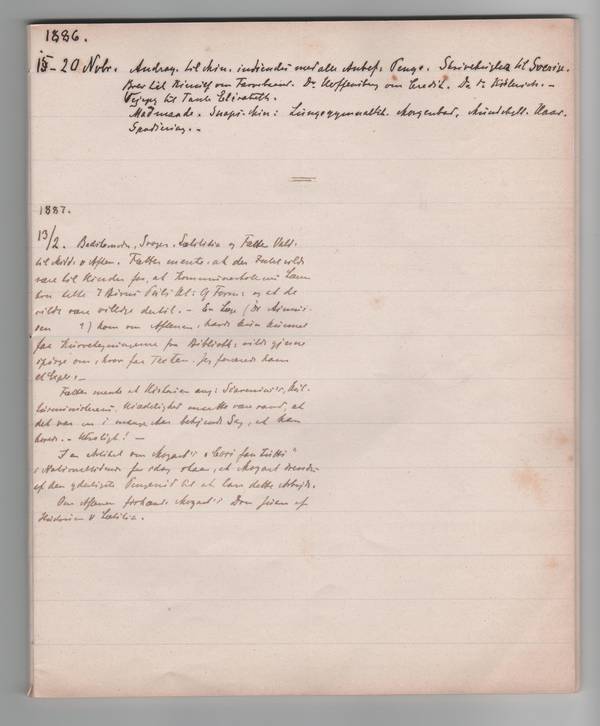1887.02.13 English
Diary notes by RMH dated February 13, 1887[1]
1887.
13/2. Grandmother, brother-in-law, Lætitia[2] and cousin Vald.[3] for dinner in the evening. Cousin felt that there would be nothing to prevent teachers of the public schools to check the pulse of 7 children each at 09.00 AM and that they would do it willingly.[4] – A physician (Dr Asmussen ?) called in the evening, had only been able to get the graphic drawings from the library; wanted to ask where to get the text. I gave him a copy. -[5]– Cousin thought that the history about the immorality of the minister of culture, Scavenius, must be true, that it had been known for many years that he fornicated. – Incredible ! - [6] In an article about Mozart’s “Cosi fan tutti” in “Nationaltidende” of today it is said that Mozart was driven to produce this piece of work by utter pecuniary distress. In the evening a piano duet, wife and Lætitia playing Mozart’s Don Juan.[7]
[1] JMC: This short diary entry stems from papers in the possession of Elsebeth Erlangsen (1904-1995), daughter of Emma Mathiesen, and she kindly let us have copies. EE has made an attempt to transcribe RMH’s handwritten text, very difficult to make out. In the transcription above I have kept the layout and format used by RMH.
SA: We owe Elsebeth Erlangsen deep gratitude for her great interest for preserving everything connected to the life and work of her grandfather. Her descendents today own a great deal of pictures, documents and letters collected by her over the years, and they have very generously permitted us to copy everything in their possession. In 2006 I spent a weekend with them in Copenhagen, scanning the entire collection.
[2] SA: ”Grandmother” is probably RMH’s mother-in-law Abelone Antoinette Steenstrup, called Lone, née Lyngbye, 1814 – 1906. Brother-in-law and Lætitia I take to be RMH’s wife’s brother Peter Wilhelm Vogelius Steenstrup, 1850 – 1897, a judge by profession, and his wife Lætitia born 1856.
[3] SA: Unfortunately I have not found out who cousin Valdemar might be. He could be either a cousin of one of RMH’s two wifes or his own cousin. RMH’s two wives had between them more than 40 uncles and aunts (in the families of Lyngbye, Rørdam, Heiberg and Steenstrup), so undoubtedly there must be a vast number of cousins to look for. Unfortunately we don’t know sufficiently about RMH’s own family to be able to pinpoint his cousins, but is seems as if this particular Valdemar is also an educationalist. There is of course also the possibility that it could be a cousin of one of his brothers’ wives (in the families Thaning or Jeppesen)
[4] SA: In this period RMH was intensively occupied by his research into the growth of children and their weight increases in cycles, investigating a great many different factors in several countries and different parts of the world, that might have a bearing on the growth of children. On reflection, it is quite incredible to imagine, but he did manage to have a large number of schools and institutions measure, on a regular scale, e.g. the pulse of the children every single day over long periods of time. Whether what is referred to here – that all teachers of public schools were to check the pulse of seven students every morning – was ever turned into reality, we don’t know for sure, but at the Royal Institute for the Deaf-Mute on Kastelsvej the around 200 notebooks that RMH used to register the results of the various measurements, carried out by him or on his instructions are kept.
[5] SA: Obviously a physician appearing unannounced at the Malling-Hansen residence in order to inquire about RMH’s book about the growth of children and their weight increases in cycles.
[6] SA: Jacob Frederik Scavenius, 1838-1915, was a rather striking and forceful Danish politician, minister of culture 1880-1891 and thus RMH’s top rank superior to which he had to relate in many contexts, for instance in connection with his chairmanship of the Jonstrup jubilee in 1890. The fact that a man from the upper classes had concubines was probably not very sensational, but it is evident that RMH is shaken by this. He himself, of course, was a man with lofty ideals apart from being a reverend and a father. Presumably something like that was unthinkable for RMH himself who seems to have had a very close and loving relationship with both of his wives.
[7] SA: These were women of Copenhagen high level upper class, and being able to play the piano was probably part of their education. We know that RMH was very fond of music and, among other things, that he played organ. It was probably an integrated part of the teacher education to learn to accompany singers.


